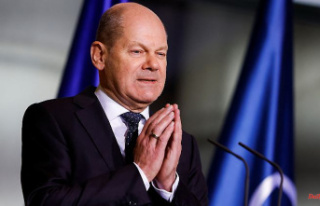Five years ago, President Trump declared a national health emergency over opioids. But in 2021, more people died from a fentanyl overdose than ever before. The reason is a series of wrong decisions.
Almost 500 deaths from fentanyl since 2018, observed alone by an investigator in San Diego, California: This personal statistic is kept by the employee of the Department of Homeland Security - and told journalists from the "Washington Post" about it. The Californian border town with Mexico is the main gateway for smuggling the synthetic painkiller into the USA. More than half of the fentanyl seized at the southern border is discovered here.
The United States have failed with their previous countermeasures. More have died there from opioid overdoses than soldiers in the wars in Vietnam, Iraq and Afghanistan combined. It's also more than in car accidents, suicides or gun violence. In 2013 the numbers started to increase. According to research by the "Washington Post", which is based, among other things, on information from the anti-disease institute CDC and the Department of Health, fentanyl is now the most common cause of death in the 18 to 49 age group.
Most start their drug careers with legal painkillers and switch to other opioids because of the price advantage. The total number of overdose deaths in the past year is estimated at 107,622, an all-time high. Two-thirds of these people died from fentanyl. Officially, there are three million addicts in the United States, but the substance is extremely dangerous, and many of the victims have not previously noticed.
As of 2017, fentanyl is the most commonly used compound in overdose deaths. The USA has therefore been officially in a national health emergency for five years. No president has been able to solve the problem, which has to do with a whole series of bad decisions.
Fentanyl is extreme: Two milligrams is enough for an overdose, it has 50 times the potency of heroin and 100 times that of morphine. For manufacturers, especially illegal ones, this means: less risk, much less quantity, much more profit. The substance has been approved as a prescription pain reliever since 1972. Because of its high potency, it is often used in cancer patients or post-surgery patients, or as a stronger opioid for those who have become weak on other drugs. Fentanyl can induce heroin-like euphoric feelings, but it also has potential side effects such as breathing difficulties, low blood pressure, and dizziness.
Part of the problem in the illicit market is the mix: Many drug dealers sell cheap, illegally produced fentanyl or mix it with heroin, cocaine or counterfeit painkillers. You deserve more that way. If the consumers do not know about it, they cannot dose accordingly and die. The number of deaths from fentanyl in the US has almost doubled since 2019. Continuously updated figures are not publicly available. An estimated 196 Americans die each day from fentanyl.
After Donald Trump came to the White House, the fentanyl crisis spread across the United States. The ex-president's wall, which was supposed to stop immigrants and also drug smuggling, did not bring any measurable success. The substances continue to make their way north. Biden's government has not found a quickly effective antidote either. But how did it even come about? The "Washington Post" has also worked on this in detail.
When ex-President Richard Nixon launched the war on drugs half a century ago, there had been 6,771 overdose deaths in one year, a small fraction of today's deaths. The Drug Enforcement Agency (DEA), founded under Nixon in 1973, is currently facing the biggest challenge of its existence. Some call it the greatest threat to national security today.
According to the US media, it was a whole series of wrong decisions that led to the current catastrophe. Even under George W. Bush, many Americans were addicted to prescription opioids such as ocycodone. Under his successor Barack Obama, monitoring programs were canceled and the president banned the drug commissioner - the so-called "drug czar" - from his cabinet. When the government cracked down on prescription opioids, use of heroin, used as a substitute, increased.
At the same time, the Department of Homeland Security, which is responsible for border security, has failed to effectively curb smuggling. The fentanyl laboratories are often located in Mexico. It is produced as a white powder by illegal laboratories, pressed into tablet form in the north of the neighboring country, and then shipped by the millions across the border to interim storage facilities in Los Angeles or Phoenix, from where it is distributed across the country. Drug cartels rent apartments there from which they send the pills.
All of this is happening even though billions of dollars flowed south under Trump to expand the border installations there. Under him, the position of drug czar remained vacant for months, even though he too recognized the urgency of the situation. He then appointed Rep. Tom Marino -- who resigned after US media discovered and publicized his involvement in legislation that had made it harder for the DEA to prosecute drug manufacturers and distributors. The White House did not present a continuously adapted anti-drug strategy during Trump's tenure.
But he declared the opioid crisis a national health emergency in October 2017. This has been renewed every few months since then. In the past five years, the amount of fentanyl seized has increased ninefold. At the time, Trump's employees publicly stated that most of the fentanyl came from China. Investigators in San Diego already had the clear impression that it was coming from cartels in Mexico. The DEA all but ignored the issue in its annual report at the time.
At that time, more than 228,000 vehicles rolled north from Mexico every day. The US border agency scanned about 6 percent of trucks and 1 percent of cars. Apparently quite a few were traveling with illegal cargo. Then, in 2019, the US Congress approved additional money to increase the inspection percentage to 70 percent of trucks and 40 percent of cars; with three-dimensional scans and artificial intelligence. But the images are still manually evaluated by employees, which slows down the work.
The security authorities are also accusing the government in Washington of still not doing enough to contain the deadly threat. Investigators often only react. They then carry naxolone in syringes or as a nasal spray because it works as an antidote. In order to take action beforehand, the authorities would need the relevant data on consumers, different from deaths and delayed by more than a year.
"It's like observing an epidemic with cemetery visits," says John Walters, the drug commissioner in the White House under ex-Presidents Bill Clinton and George W. Bush. It is neither measured what enters the country nor what the health effects are and by what means they could be cushioned, he told the Washington Post.
A program that tested detainees for drug use existed until 2013, but it was shut down under Obama because of austerity measures. Data collection on drug users and those with overdoses in hospitals and emergency services ended two years earlier. It was reintroduced in 2018. In the district of San Diego, which includes the city and much of the land on the border, the special investigators registered 92 fentanyl deaths in one year. In 2021 there were 814. "So much unnecessary death," said the former chief investigator of a special unit to the "Washington Post".
After Biden became president, he installed Anne Milgram as the new DEA boss. The position had been vacant since 2015. "This is not a war on drugs, this is a war to save lives," she said of the fentanyl disaster. Under Milgram's leadership, the DEA's priority is to dry up the sources of illicit fentanyl by targeting the cash flows and global supply networks of the two powerful drug cartels, Sinaloa and Jalisco Nueva Generación.
That sounds ambitious. But even if this is partially successful, it will take time. At the same time, the Ministry of Health is trying to counteract this with its own resources. It is now easier for addicts to get methadone as a substitute. And the antidote naxolone could soon no longer require a prescription. The drug industry makes money off the legal opioids that get people addicted and the antidote afterward as well. There are many corpses in between. So the ministry's steps are just a small, desperate stopgap measure. At the same time, it is a confession: Opioids have a firm grip on the United States.












